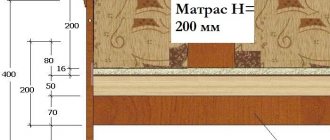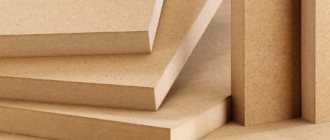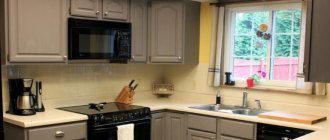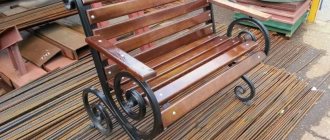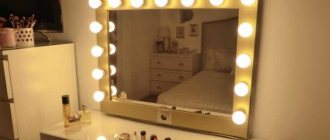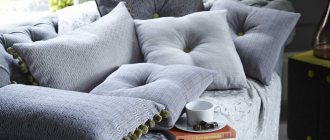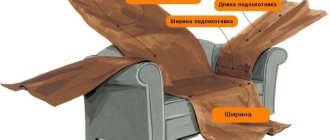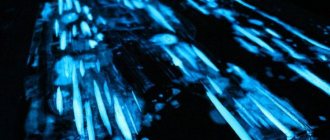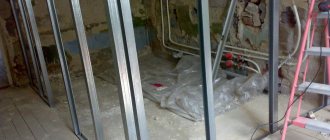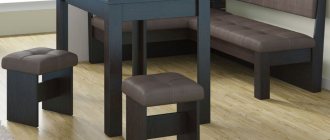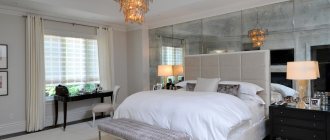Mirrors have firmly entered our lives, making it more interesting and informative. It is thanks to them that people get the opportunity to study their appearance in detail, visually expand the space, fill the room with additional light and a special aura. Once again looking at his reflection, sooner or later any person wonders how a mirror is made and why it is endowed with a magical nature. An interesting history of the creation of reflective surfaces, which dates back to the development of civilization, will help you understand these issues.
Types of mirrors
All mirror canvases are usually divided into two categories:
- with a functional purpose;
- decorative plan, which are usually used exclusively to improve the design.
| Functional | They are used so that a person can look in them while controlling his appearance. They are installed in visible and easily accessible places: bathrooms, hallways. There are cases when living rooms are equipped with mirrors to make them look larger visually. |
| Decorative | They don't look like people. They are intended to become a decoration of the room. |
There are many types of mirrors, and there is no shortage of choice. It all depends on individual preferences, the size of the premises, and financial capabilities. Today, retail outlets can offer the following unusual types of mirrors:
- mirrors patinated look (made in antique style). In this case, special chemicals are used;
- mirrors beveled (having beveled edges, most often in the form of diamonds);
- mirrors tinted or colored (look great in modern interiors);
- mirrors with ornaments, patterns, drawings and all kinds of inscriptions.
Types of products
Currently, there is no shortage of mirrors, and the cost of these products is quite affordable. People use all sorts of variations of reflective surfaces, among which there are cosmetic mirrors:
- Road. During the production of such models, shock protection is provided, and the products themselves are compact in size specifically for ease of transportation.
- Pocket. These are models that resemble a lady's powder compact. They come in miniature sizes and usually need to be folded and closed before being put into a pocket or bag.
- Shaving mirrors. The products are equipped with a special stand and are sometimes equipped with lighting for the convenience of the owner.
- Bags. Manufacturers of accessories insert them into frames for convenience; with their help, the owner will be able to control her appearance in any conditions.
Road
Pocket
For shaving
Bag
Interior mirrors are presented in an equally extensive range:
- wall ones have a wide variety of shapes - from classic geometric shapes to bizarre configurations;
- tabletop ones are equipped with a stand to place the product on a table or windowsill;
- mirror panels are hung on the walls, they are available in different models and are more of a decoration than a functional item;
- tiles with a reflective surface are used in room design to expand the space.
Wall mounted
Desktop
Panel
Reflective tiles
The edge of the mirror sheet is designed in different ways:
- Bevelling is a technology that involves removing sharp edges from the fabric. Edge grinding using this method is used in the production of furniture, equipment for retail and exhibition halls, and in the design of stands where mirrors with an open edge are provided.
- Euroedge – professional edge processing and polishing of the mirror end. This technology is used in furniture production, for countertops, partitions, mirror steps, glass doors and more.
- Polishing removes rough areas on the edges of the mirror. It is carried out along the perimeter of the canvas until the edge of the product becomes transparent. Polishing is used after cutting and polishing the mirror.
- The raw edge of the mirror remains after cutting. This canvas often serves as a decorative element in interior design.
The ends of the product are processed so that the mirror can be used safely, without the risk of injury from sharp edges.
Facet
Euroedge
Polishing
Raw edge
DIY materials for mirrors
To start making a mirror with your own hands, you need to decide what it will be made of. The following materials can be used:
- plastic;
- glass;
- cardboard;
- foil;
- metal.
Currently, plastic is in great demand as a reflective surface. But the technology for manufacturing such items is quite complex, and special vacuum equipment is used, the storage of which at home is impractical, unless the family has a mirror manufacturing business.
As for glass and metal, they can be used at home; highly professional equipment is not required. When silvering a mirror, you will need certain chemical reagents, but they can be easily purchased. The metal is replaced by its analogues - foil. It will be almost impossible to achieve a special quality mirror, and it will be inferior to metal and glass specimens.
Foil - a budget replacement for a mirror surface
Mirror technology
For the production of mirror paintings, raw materials are selected carefully and responsibly. Only clean and high-quality polished glass passes the test. The mirror manufacturing technology includes the following steps:
- The glass base is prepared for the application of a reflective layer. To do this, the glass is washed in a weak soda solution, as a result of which it is cleaned of dirt, dust, grease and everything unnecessary.
- Glass washed in a soda solution is thoroughly lubricated with chalk, which consolidates the cleaning result and prevents the glass sheet from getting dirty again. The glass remains in this form until the next stage.
- The glass sheet is cleaned of traces of chalk using a soft cloth, after which it is immersed in the bath almost to the very bottom. At the bottom of the bath is a metal mortar used to coat the glass.
- As a result of contact between glass and metal solution, a reflective layer is formed. It is instantly fixed on the surface of the glass, but still requires final processing - this is done further.
- The mirror cloth is thoroughly washed using distilled water. At this stage, contaminants are removed. After cleaning in water, the newly made mirror goes through a thorough drying stage.
- The final stage of making a mirror is varnishing. The reflective layer is covered with a layer of asphalt varnish. Once dry, this layer prevents mechanical defects on the glass.
If there is such a need, a layer of copper is applied to the glass before lowering the glass sheet into a bath with a metal solution. After drying, the product acquires high strength and resistance to stress. The steps listed above are performed under conditions of absolute sterility. Otherwise, even one speck of dust that gets under the metal layer during the drying stage completely ruins the mirror product.
Metal mirrors
It must be remembered that not all metals can be used in the manufacture of mirrors. It is worth using only those that tolerate grinding well. These include:
- steel;
- bronze;
- aluminum;
- silver;
- gold;
- special alloys;
- beryllium.
To find large silver or gold plates, you need to try hard, and their cost will be exorbitant. Moreover, expensive alloys are classified as soft and will not be able to rigidly hold the shape of the mirror. Therefore, they are mainly used only for spraying a surface reflective layer.
Bronze has been used since ancient times. Due to its hardness, it withstands polishing. And this is enough to make a mirror surface.
Steel is considered a younger material compared to bronze. It is widely used to produce reflective surfaces. The principle of working with steel is the same as in the previous version: a cast whole mirror surface is purchased and simply polished. To ensure that the surface has a sufficient reflective effect, it can be silvered, but you don’t have to do this.
Do-it-yourself polishing of stainless steel to a mirror finish
You can watch the video for more details about the process of polishing the material to a mirror-like appearance (in English, but it’s not important here):
Aluminum mirrors are also common. Products made from it are light and cheap, but they have a lot of negative aspects:
- aluminum is quite difficult to polish due to its soft structure, so this procedure takes a lot of time and nerves;
- softness does not allow the mirror to maintain its correct shape.
Beryllium and other special alloys are used in the production of mirrors at industrial enterprises with specialized equipment. Beryllium is very hard and toxic, so it is usually only used to coat objects.
How safe mirrors are created
Safety mirrors are made from different materials. There are surfaces made of acrylic, special unbreakable glass, in addition, there are mirror plates based on plastic made of several layers.
Safety mirrors on an acrylic basis are used for home use, in kindergartens, entertainment centers and playrooms. Such accessories are made to order. They do not break, weigh little, do not contain harmful substances and clearly convey the image. Such products can be produced in any form. Mirror acrylic lends itself well to processing. It is not afraid of moisture, so it can be used in bathrooms and swimming pools. This is one of the best and safest options for children to use.
For a child's room, you need to choose mirrors that do not have sharp edges. The surface must be securely fixed. It is better if the mirror sheet is made of plastic. If you couldn’t find one, you can use a special interior film that covers the mirror surface, and if it is damaged, it will hold the fragments, preventing them from falling apart.
Choosing glass for a mirror
If the choice is made of glass, then it should be selected carefully. Bohemian quality is best - it has a well-polished surface and is practically not subject to mechanical damage. It costs expensive.
But you can also take a regular window option, only there are certain requirements for it: its surface should not be covered with shells, cracks and visible scratches. The glass sheet must have perfect evenness and this is checked in the following way:
- The glass is placed on a flat surface covered with a dark cloth;
- A lamp is installed nearby;
- The metal measuring ruler is carefully applied to the surface so as not to cause damage;
- The lamp is directed onto the glass so that the divisions of the measuring instrument are visible on the glass surface;
- If the glass is smooth, then along the entire length of the ruler there will be no gaps between it and the surface, and its divisions will clearly correspond to the reflection without breaks.
Once the choice of glass is made, it must be cut along the contour. It is worth using a sketch that is cut out of cardboard. Such actions require a little experience, and if you do not have it, then let a specialist do the pruning. When performing such actions, precision is necessary to avoid chips and nicks.
But if you decide to carry out all the work yourself, use a glass cutter with a cutting disc. It's better than diamond.
Glass cutting
How is glass made?
How are the glasses themselves made for the base of mirror products? The composition of glass includes the following elements: soda, quartz sand, dolomite, coal and feldspar. The starting components are ground and thoroughly mixed. As a result, a glass charge is formed - a fine powder that is melted in a furnace at a temperature of more than 1500°C. At the exit of the furnace, a large sheet of glass is obtained, which is sent for cutting.
Now you know how and what a mirror is made of. We invite you to find out more useful and relevant information about the topic of mirrors in the blog on the website www.miradeco.ru. Here, in the online store, you will find a large selection of ready-made mirrors, as well as the opportunity to inexpensively order a mirror cloth according to an individual sketch.
How to make a glass mirror with your own hands
In order for the mirror to turn out to be of high quality and to serve for a long time, it is necessary to strictly follow the following manufacturing technology:
- Select a table with the correct horizontal surface and place glass on it. To avoid breaking it during the wiping process, you need to place something soft under it.
- Pour polishing liquid over the glass surface. A ready-made “Polish” will do. Then the glass is thoroughly wiped with soft felt, felt or leather.
- Wipe the glass with gauze, previously soaked in distilled water containing a suspension of crushed pumice powder. Afterwards the surface is washed with distilled water.
- Take a wet sponge and wipe the surface with it. Then do the same using gauze swabs that are moistened with a 15% tin chloride solution, repeat the procedure several times. Rinse and wipe thoroughly using a swab.
- After completing these actions, the glass will first become dark, and then quickly lighten due to the fact that silver begins to precipitate. If dark spots appear on the glass surface, they must be removed immediately by wiping with a swab soaked in a pumice suspension, and then using gauze soaked in a solution of stannous chloride. At the end, fill the area again with freshly prepared solution.
- After 7-10 minutes have passed from the start of using gauze or suede for silvering, heavily moistened in distilled water, carefully remove the liquid from the glass in order to pour the mixture there again.
- After 15 minutes, the surface is washed with distilled water. In this case, one edge of the glass rises and the surface is filled with liquid. To determine whether the thickness of the silver deposit is sufficient, you need to look through a mirror at an electric lamp (60W). Its contours should be slightly visible.
- For a mirror to be durable, it must be subjected to high temperatures. In this case, the mirror is given a vertical position and kept in this form at 100 - 150 degrees.
- The “baked” silver film is coated with a mirror-like waterproof varnish. This is done using a spray bottle. As soon as the varnish dries, a thick layer of paint or asphalt varnish is applied to the surface. Coating on mirrors should be done in one direction.
- The final touch is to remove silver stains from the front side using a weak solution of hydrochloric acid using a swab. The making of the mirror is completed.
- If, during the manufacture of the product, droplets of silver get on the skin and clothing, then the stained areas are wiped with sodium hyposulfite and then thoroughly washed off with warm water.
You can also watch an interesting video on how to make a glass mirror using paint and enamels:
What is the product
Mirror reflections help analyze appearance and inspect the surroundings. In ancient times, people could only see their reflection on the surface of the water. The modern product consists of glass and a reflective layer. The production of models in this form began relatively recently. Previously, people used other devices:
- polished metal plates;
- polished semi-precious stones;
- polished gems.
Any materials that had a high degree of reflectivity were used. The Industrial Revolution gave impetus to the development of mirror production technologies. Glass base, spraying or reflective material, frame - the standard design has survived to this day.
Archaeologists have found the first prototypes of mirrors inside the ruins of palaces and tombs. The frames were made of ivory or semi-precious stones and inlaid with pearls.
Modern reflective products are produced using standard technology. Three methods are popular:
- spraying amalgam, aluminum, titanium, and various alloys onto glass;
- creating mirrors from a solution of silver with copper and chemicals;
- deposition of silver on a celluloid surface.
The product created in production consists of glass, amalgam, protective paint and frame. The latter directly affects the cost. Often, cleaned glass and raw materials for sputtering are produced in the same plant. Mirrors are created from the following components:
- soda;
- dolomite;
- glass fragments;
- coal;
- sand quartz.
Regardless of how the mirror is made, the composition remains virtually unchanged. Silver or titanium oxide is prepared for spraying. A smooth glass sheet should have the smoothest possible surface and a high level of cleaning. All cooled layers are checked for defects before spraying is applied.
Straight and curved bevels on the mirror - what are they and what are they for?
The structure of the mirror plate
How to make a metal mirror with your own hands
Bronze and steel sheets can be purchased from a foundry. The Internet can also be used, but you should pay attention to the evenness of the surface in the information. The polishing process takes quite a long time and requires significant labor costs, but the surface layer will be perfect.
The surface is polished using abrasive powder. For a larger binder, solid oil is used. Grinding occurs using a flat iron plate with a smooth surface or a thick sheet of glass. The steps should be like this:
- The sanding pad is placed horizontally.
- An abrasive mixed with grease is applied to the workpiece.
- The workpiece moves along the grinder in various directions, but it should not be brought to the edges.
- The workpiece and grinding pad are freed from the abrasive composition using a flannel rag.
- A soft-grain abrasive is applied on top and the procedure is repeated.
The abrasive is applied up to 6 times, with each subsequent application using a softer fraction. Once the surface is ready, it is polished with GOI paste without using a grinder.
How to make a mirror from foil with your own hands
The most affordable way to become the owner of a hand-made mirror. Retail outlets can offer a huge selection of this material, but it’s worth focusing on the thinnest foil that exists in nature. The most suitable option would be window foil, which protects rooms from sunlight in the summer.
Manufacturing does not require special skills or effort. The glass must be smooth. Take a sheet of foil and cut it to the shape of glass. Then it is glued on the sides. The mirror is inserted into the frame and the product is ready. No complications or negative impact on human health. You can also attach the foil to the glass with tape.
Cardboard mirror
The cardboard must have sufficient density and thickness. It can also be attached to a more rigid material, such as plywood. It is worth purchasing mirror auto enamel in a can and coating the workpiece with it. The finished product will not last long, and its strength will be minimal, and the reflective surface will be of poor quality. But there is a main advantage of such a mirror: it can be given any shape and decorated in any style.
Mirror cardboard
How to make a frame for a mirror with your own hands
You can make not only mirrors, but also frames for them yourself, using all your imagination. The choice of materials for manufacturing is so wide that you should be guided only by your own preferences, the style of the room and financial abilities.
An example of making a frame for a mirror
Don't think that the frame is a very expensive part. You can even use cardboard and paper tubes for a beautiful frame. Moreover, such a miracle can be done with the participation of all family members, even the smallest. Let's look at some interesting options.
- Frames made of polyurethane. They are durable and lightweight, and are not afraid of excessive humidity. You can always change its color by simply repainting it. Polyurethane molding is used for round and oval mirrors. This frame is easy to make.
- Metal frames. You can use aluminum as a thin and manageable material. If forging will look beautiful, it requires a professional approach, although the look will be unique.
- Mirror glass for frames has gained well-deserved popularity. You don't need any great skills to make it. You can purchase special coated glass or use many small glasses.
- The leather frame is quite original. It can have a voluminous appearance if filled with padding polyester. Instead of leather, you can use good quality leatherette. It is more profitable and not everyone can distinguish it from natural canvas.
- Rope frame. A rather non-standard proposal, but it will make the room more comfortable. Disadvantages include fear of moisture, temperature changes, and impracticality.
- Wooden frames. If you have already worked with this material, then building a frame will not give you much trouble. You can make a carved product, choose a specific design.
How to make a mirror with your own hands - instructions with photos and videos
5 (100%) 1 vote
What is a “site mirror”: meanings and types
In general, webmasters often mean different things by mirrors. And the goals of such mirrors are also different: site security, change of address and some others. I will tell you about all this below.
Mirror is a duplicate, a copy of the site. Mirroring your own or someone else's website can be complete or partial.
At the same time, the deeper concept of “mirror” is used in different contexts and can take on slightly different meanings:
- Duplicate version of the site with “www.” at the beginning of the address or without. For example www.15blogggers.ru and simply 15bloggers.ru. If done the old fashioned way, such versions will be considered by search engines to be different sites (albeit identical in content) and they will need to be merged for correct SEO.
- Another domain attached to the main site - when both addresses are “glued” with the same content. In this case, a copy of the main site will be shown at both addresses, regardless of which domain you make the main one - new or old. Such a copy may even be located on another server. This practice is common among large sites, when several domains use copies of the same database hosted on different servers. If one copy of the site fails, you can go to another.
It’s difficult to say definitely which option is used more often: most likely, for small sites it’s definitely the first one, for large sites it’s the second one.
So, Yandex and Google robots consider complete copies of sites as mirrors. A copy is determined when the content matches at two different addresses, for example: 7bloggers.ru/about-2 and 15blogggers.ru/about-2 or 7bloggers.ru/about-2 and www.15blogggers.ru/about-2.
At the same time, identical content can be shown both with and without redirection. In case of redirection, a redirect occurs from 7bloggers.ru/about-2 to www.15bloggers.ru/about-2. In the absence of a redirect, the content is simply shown at two addresses, but the main mirror and only it participates in the search results.
